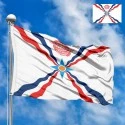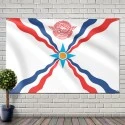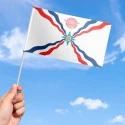Assyrian Flag
- Flag Type: Ethnic
- Proportions (official): 2:3
- Population: 3,000,000 (2024, estimate)
Flag Information
Demography and Culture
- All Flags
- Flags of Countries by Continent
-
Flags of Organizations
- Flags of UN countries
- Flags of the European Union countries
- Flags of NATO countries
- Flags of the countries of the Organization of Islamic Cooperation
- Flags of the countries of the Organization of American States
- Flags of the Arab League countries
- Flags of the African Union countries
- Flags of the countries of the Union of South American Nations
- Flags of the Commonwealth of Nations
- Flags of the countries of the Secretariat of the Pacific Community
- Flags of the Nordic Council countries
- Flags of the Caribbean Community
- Flags of the countries of the Association of Southeast Asian Nations
- Flags of the East African Community
- Flags of the countries of the Organization of Turkic States
- LGBT Community Flags
- Historical Flags
- Ethnic Flags
- Flags of the USA (states)
Description
The Assyrian flag is a modern and profoundly symbolic representation of the Assyrian people's ancient heritage, their historical homeland in Mesopotamia, and their enduring spirit. Adopted in 1968, the flag is not tied to a single state but serves as a unifying emblem for a dispersed global community. It visually narrates the history, struggles, and hopes of a people with roots stretching back thousands of years.
Design and Symbolism
The Assyrian flag is a striking design featuring a white field with a golden circle at its center. Four wavy stripes emerge from the circle, extending to the corners of the flag. Above the circle is a figure of the ancient Assyrian god Assur.
-
The White Field: The white background represents peace and purity, symbolizing the unity of the Assyrian people.
-
The Central Golden Circle: The golden circle is the sun, which, with its burst of light, disperses darkness and shines upon the land, representing a prosperous future for the Assyrian people. It also symbolizes the life-giving energy that sustains all things.
-
The Wavy Stripes: The four stripes symbolize the great rivers of the Assyrian homeland in Mesopotamia. The two prominent red and blue stripes represent the Tigris and Euphrates rivers, respectively. The thinner white stripes represent the Great Zab river. The stripes’ wavy nature signifies the rivers flowing into the sea, and their widening from the center outward symbolizes the Assyrian people’s dispersion across the globe.
-
Red stripes: Stand for courage, military strength, and the blood of Assyrian martyrs who died for their freedom and honor.
-
White stripes: Represent peace, purity, and the unity of the Assyrian people.
-
Blue stripes: Symbolize the Euphrates River and its contribution to the ancient Assyrian civilization, as well as the tranquility of the homeland.
-
-
The God Assur: The figure above the sun is the ancient Assyrian god Assur, depicted as a warrior with a bow and arrow. This symbol, historically used on ancient Assyrian banners, represents the strength and power of the Assyrian people and their readiness to protect their land.
History of Creation and Adoption
The modern Assyrian flag was designed in 1968 by the artist and activist David Odisho. It was a response to the growing need for a national symbol that could unite Assyrians worldwide. Following its design, it was quickly adopted by numerous Assyrian political and cultural organizations and came to be recognized as the official flag of the Assyrian people. Its creation marked a significant moment in the modern Assyrian nationalist movement, providing a powerful visual identity that bridged their ancient past with their contemporary reality as a diaspora community.
Flag Size and Proportions
The flag is typically produced in the standard vexillological proportion of 1:2 (height to width), a common ratio for flags worldwide. The central emblem and the layout of the stripes are meticulously balanced to ensure the symbolism is clear and aesthetically pleasing.
The People, their Region, and the Flag's Significance
The Assyrians are one of the world’s oldest Christian peoples, with roots in ancient Mesopotamia (the land between the Tigris and Euphrates rivers), corresponding to parts of modern-day Iraq, Syria, Turkey, and Iran. The flag is the emblem of a people, not a sovereign state. It serves as a vital symbol for Assyrians living in their ancestral homelands and for the large diaspora community scattered across the globe. It is a powerful reminder of their ancient heritage and their continuous existence as a distinct cultural group. For the Assyrian people, the flag symbolizes their shared identity, their collective memory of persecution, and their hope for a future of peace, security, and a return to their ancestral land. It is a source of immense pride and a rallying point for cultural preservation and political self-determination.
Interesting Facts
-
The flag was designed by an artist and was not an official state banner, yet it is recognized and used globally by Assyrian communities, demonstrating its widespread acceptance.
-
The design intentionally combines ancient symbols, such as the god Assur and the river representations, with modern vexillological principles, making it both historically significant and visually compelling.
-
The flag’s central theme of the sun radiating light and the rivers flowing outward from the homeland beautifully captures the story of the Assyrian people, who have been forced to leave their ancestral lands but carry their culture and history with them wherever they go.
-
The Assyrian flag is a rare example of a national symbol that almost perfectly encapsulates the history, geography, and aspirations of a people who have existed for millennia without a recognized sovereign state.
In essence, the Assyrian flag is a tapestry of history, a beacon of hope, and a powerful symbol of a people’s unbreakable will to survive and thrive.
In the demonstration images, full-size flags are shown with proportions of 2:3, and hand-held flags with proportions of 1:2.
Donation
Download
Completely free for commercial and non-commercial use (public domain).
You can freely use them in your news magazines, websites, software, mobile applications.
We appreciate a backlink to https://flagssite.com
Raster files - Assyrian Flag (PNG, JPG)
 Waving flag
Waving flag
- PNG format (transparent background), 72dpi, dimensions in Pixels (px), aspect ratio 3:4.
- 15х20 px
- 30х40 px
- 60х80 px
- 120x160 px
- 240x320 px
 Sizes:
Sizes:
"v15" - image size (by height); if necessary, replace with available: v15, v30, v60, v120, v240.
!!! For resizing, use the Latin (eng) keyboard layout.
<img src="https://flagssite.com/flags/v15/20904.png" alt="Assyrian Flag">
 Round flag
Round flag
- PNG format (transparent background), 72dpi, dimensions in Pixels (px), aspect ratio 1:1.
"d15" - image size (diameter); if necessary, replace with available: d15, d30, d60, d120, d240.
!!! For resizing, use the Latin (eng) keyboard layout.
<img src="https://flagssite.com/flags/d15/20904.png" alt="Assyrian Flag">
 Rectangular flag 2:3
Rectangular flag 2:3
- JPG format, 72dpi, dimensions in Pixels (px), aspect ratio 2:3.
"h30" - image size (by height); if necessary, replace with available: h15, h30, h60, h120, h240, h360, h480.
!!! For resizing, use the Latin (eng) keyboard layout.
<img src="https://flagssite.com/flags/h30/20904.jpg" alt="Assyrian Flag">







 Sizes:
Sizes:
 Sizes:
Sizes: